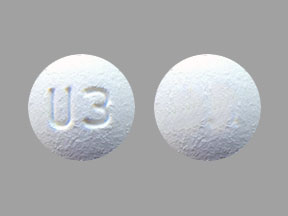Alunbrig Dosage
Generic name: brigatinib 30mg
Dosage form: tablet, film coated
Drug class: Multikinase inhibitors
Medically reviewed by Drugs.com. Last updated on Oct 24, 2024.
Patient Selection
Select patients for the treatment of metastatic NSCLC with ALUNBRIG based on the presence of ALK positivity in tumor specimens.
Information on FDA-approved tests for the detection of ALK rearrangements in NSCLC is available at http://www.fda.gov/CompanionDiagnostics.
Recommended Dosage
The recommended dosage for ALUNBRIG is:
- 90 mg orally once daily for the first 7 days; then increase the dose to 180 mg orally once daily.
Administer ALUNBRIG until disease progression or unacceptable toxicity.
If ALUNBRIG is interrupted for 14 days or longer for reasons other than adverse reactions, resume treatment at 90 mg once daily for 7 days before increasing to the previously tolerated dose.
ALUNBRIG may be taken with or without food. Instruct patients to swallow tablets whole. Do not crush or chew tablets.
If a dose of ALUNBRIG is missed or vomiting occurs after taking a dose, do not administer an additional dose and take the next dose of ALUNBRIG at the scheduled time.
Dosage Modifications for Adverse Reactions
ALUNBRIG dosage reductions for adverse reactions are summarized in Table 1.
| Dosage Reduction | |||
|---|---|---|---|
| Dosage | First | Second | Third |
|
|||
| 90 mg once daily | 60 mg once daily | permanently discontinue | N/A* |
| 180 mg once daily | 120 mg once daily | 90 mg once daily | 60 mg once daily |
Once reduced for adverse reactions, do not subsequently increase the dosage of ALUNBRIG. Permanently discontinue ALUNBRIG if patients are unable to tolerate the 60 mg once daily dose.
Recommendations for dosage modifications of ALUNBRIG for the management of adverse reactions are provided in Table 2.
| Adverse Reaction | Severity* | Dosage Modifications |
|---|---|---|
| bpm = beats per minute; DBP = diastolic blood pressure; HR = heart rate; SBP = systolic blood pressure; ULN = upper limit of normal | ||
|
||
| Interstitial Lung Disease (ILD) /Pneumonitis | Grade 1 |
|
| Grade 2 |
|
|
| Grade 3 or 4 | Permanently discontinue ALUNBRIG for ILD/pneumonitis. | |
| Hypertension | Grade 3 hypertension (SBP greater than or equal to 160 mmHg or DBP greater than or equal to 100 mmHg, medical intervention indicated, more than one antihypertensive drug, or more intensive therapy than previously used indicated) |
|
| Grade 4 hypertension (life-threatening consequences, urgent intervention indicated) |
|
|
| Bradycardia (HR less than 60 bpm) | Symptomatic bradycardia |
|
| Bradycardia with life-threatening consequences, urgent intervention indicated |
|
|
| Visual Disturbance | Grade 2 or 3 visual disturbance | Withhold ALUNBRIG until recovery to Grade 1 or baseline, then resume at the next lower dose (Table 1). |
| Grade 4 visual disturbance | Permanently discontinue ALUNBRIG. | |
| Creatine Phosphokinase (CPK) Elevation | Grade 3 or 4 CPK elevation (greater than 5× ULN) with Grade 2 or higher muscle pain or weakness |
|
| Lipase/Amylase Elevation | Grade 3 lipase or amylase elevation (greater than 2× ULN) |
|
| Grade 4 lipase or amylase elevation (greater than 5× ULN) | Withhold ALUNBRIG until recovery to Grade 1 or less (less than or equal to 1.5× ULN) or to baseline, then resume ALUNBRIG at next lower dose (Table 1). | |
| Hepatotoxicity (Elevation of alanine aminotransferase (ALT) or aspartate aminotransferase (AST)) | Grade 3 or 4 elevation (greater than 5 × ULN) of either ALT or AST with bilirubin less than or equal to 2 × ULN | Withhold ALUNBRIG until recovery to Grade 1 or less (less than or equal to 3× ULN) or to baseline, then resume ALUNBRIG at next lower dose (Table 1). |
| Grade 2 to 4 elevation (greater than 3 × ULN) of ALT or AST with concurrent total bilirubin elevation greater than 2 × ULN in the absence of cholestasis or hemolysis | Permanently discontinue ALUNBRIG. | |
| Hyperglycemia | Grade 3 (greater than 250 mg/dL or 13.9 mmol/L) or 4 | If adequate hyperglycemic control cannot be achieved with optimal medical management, withhold ALUNBRIG until adequate hyperglycemic control is achieved and resume at the next lower dose (Table 1) or permanently discontinue ALUNBRIG. |
| Other | Grade 3 |
|
| Grade 4 |
|
|
Dosage Modifications for Strong or Moderate CYP3A Inhibitors
Avoid coadministration of strong or moderate CYP3A inhibitors during treatment with ALUNBRIG. If coadministration of a strong CYP3A inhibitor cannot be avoided, reduce the ALUNBRIG once daily dose by approximately 50% (i.e., from 180 mg to 90 mg, or from 90 mg to 60 mg). If coadministration of a moderate CYP3A inhibitor cannot be avoided, reduce the ALUNBRIG once daily dose by approximately 40% (i.e., from 180 mg to 120 mg, 120 mg to 90 mg, or from 90 mg to 60 mg). After discontinuation of a strong or moderate CYP3A inhibitor, resume the ALUNBRIG dose that was tolerated prior to initiating the CYP3A inhibitor.
Dosage Modifications for Moderate CYP3A Inducers
Avoid coadministration of moderate CYP3A inducers during treatment with ALUNBRIG. If coadministration of a moderate CYP3A inducer cannot be avoided, increase the ALUNBRIG once daily dose in 30 mg increments after 7 days of treatment with the current ALUNBRIG dose as tolerated, up to a maximum of twice the ALUNBRIG dose that was tolerated prior to initiating the moderate CYP3A inducer.
After discontinuation of a moderate CYP3A inducer, resume the ALUNBRIG dose that was tolerated prior to initiating the moderate CYP3A inducer.
Frequently asked questions
More about Alunbrig (brigatinib)
- Check interactions
- Compare alternatives
- Pricing & coupons
- Drug images
- Side effects
- During pregnancy
- FDA approval history
- Drug class: multikinase inhibitors
- Breastfeeding
- En español
Patient resources
Professional resources
Related treatment guides
Further information
Always consult your healthcare provider to ensure the information displayed on this page applies to your personal circumstances.


